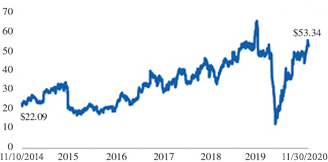Part III
ITEM 10. |
DIRECTORS, EXECUTIVE OFFICERS AND CORPORATE GOVERNANCE |
On November 30, 2020, we successfully completed the
spin-off
of our former Aaron’s Business operating segment to our shareholders (the “Spin-Off”),
which is now a standalone publicly-traded company operating as The Aaron’s Company, Inc. (“The Aaron’s Company”). As described in further detail below, the Spin-Off
resulted in a number of leadership changes at the Company. For example, each of Kelly H. Barrett, Walter G. Ehmer, Hubert L. Harris and John W. Robinson departed our Board of Directors and joined the Board of Directors of The Aaron’s Company. We thank Ms. Barrett and Messrs. Ehmer, Harris and Robinson for their leadership and many contributions to our Company and we wish them well in their future endeavors. In connection with this transition, our new President and Chief Executive Officer, Steven A. Michaels, joined our Board of Directors. Set forth below is information regarding each of our directors, including the experience, qualifications, attributes and skills that our Board of Directors believes makes each of them well qualified to serve as directors of the Company.
Directors
 |
Kathy T. Betty, Among other qualifications, Ms. Betty brings over thirty years of business management and consultancy experience to our Board of Directors. Ms. Betty currently serves on the board of directors of ScottMadden as well as on the Board of Advisors for Synergy Laboratories, a private for-profit company. In addition, her non-profit leadership positions include serving on the boards of the Chick-fil-A |
1
 |
Douglas C. Curling family-run investment business, and New Kent Consulting LLC, a privacy and mergers and acquisitions consulting business. From 1997 until September 2008, Mr. Curling held various executive positions at ChoicePoint Inc., a provider of identification and credential verification services that was sold to Reed Elsevier in 2008, including serving as President from April 2002 to September 2008, as Chief Operating Officer from 1999 to September 2008 and as Executive Vice President, Chief Financial Officer and Treasurer from 1997 to May 1999. Mr. Curling also served as a director of ChoicePoint Inc. from May 2000 to September 2008. Mr. Curling currently serves on the Board of Directors of CoreLogic, a New York Stock Exchange listed company providing global property information, analytics and data-enabled services to financial services organizations and real estate professionals.Among other qualifications, Mr. Curling brings substantial experience in managing and operating businesses with privacy, data analytics and other data-enabled matters to our Board of Directors. His prior service as a chief financial officer provides him with valuable accounting and financial expertise, and his consulting experience provides him with significant mergers and acquisitions expertise, all of which is utilized by our Board of Directors. These skills and experiences qualify him to serve on our Board of Directors. | |
 |
Cynthia N. Day, Among other qualifications, Ms. Day brings significant management and financial experience to our Board of Directors. Her experience in multiple senior executive leadership positions and service on other boards, provide her with accounting and financial expertise, which are utilized by our Board of Directors. In addition, the customer base served by Citizens Bancshares Corporation is similar to that served by the Company, giving her a great understanding of their buying habits, the products they purchase and effective marketing and communication methods. These skills and experiences qualify her to serve on our Board of Directors. | |
 |
Curtis L. Doman co-founder of Progressive Leasing. Previously, he served as Chief Technology Officer of Progressive Leasing from 1999 until December 2017 and Chief Product Officer from January 2018 until December 2019. He was also President of IDS, Inc. from September 1993 until October 2015.Among other qualifications, Mr. Doman brings significant experience in technology and data analytics matters to our Board of Directors. Mr. Doman’s intimate knowledge of our Company, including as the creator of the dynamic decision-making engine used by our Progressive Leasing operating segment in evaluating underwriting criteria for our lease products, is utilized by our Board of Directors. These skills and experiences qualify him to serve on our Board of Directors. | |
 |
Steven A. Michaels Spin-Off. Mr. Michaels was also named President of the Company as of April 1, 2021. From July 31, 2020 through November 2020, Mr. Michaels served as the Chief Executive Officer of the Company’s Progressive Leasing operating segment. Mr. Michaels previously served as the Company’s Chief Financial Officer and President of Strategic Operations from February 2016 until July 31, 2020, President of the Company from April 2014 until February 2016, Vice President, Strategic Planning & Business Development from 2013 until April 2014, Vice President, Finance from 2012 until April 2014 and Vice President, Finance, Aaron’s Sales & Lease Ownership Division from 2008 until 2011.Among other qualifications, Mr. Michaels brings significant operational and financial experience to our Board of Directors. His considerable experience in senior management, and his leadership and intimate knowledge of our business provide him with strategic and operational expertise generally and for the Company specifically, which are utilized by our Board of Directors. These skills and experiences qualify him to serve on our Board of Directors. | |
2
 |
Ray M. Robinson, non-executive Chairman of Citizens Bancshares Corporation and its subsidiary, Citizens Trust Bank, the largest African American-owned bank in the Southeastern United States and the nation’s second largest. As of January 2017, Citizens Bancshares Corporation’s stock is traded only on over-the-counter Among other qualifications, Mr. Robinson brings experience in senior management and board service for numerous public companies to our Board of Directors. His service on the boards of a number of organizations of varying sizes provides him with extensive operational skills and governance expertise, which are utilized by our Board of Directors. These skills and experiences qualify him to serve on our Board of Directors. |
3



